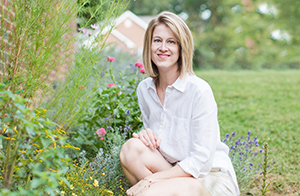My husband works in IT and I work in digital communications, so it should be no surprise that we digitized our garden last year by setting up an irrigation system and a system to control it digitally. Our software also allows us to check humidity and soil and air temperature. I am so lucky to have a super smart husband that was able to do this for me and I want to share you how we did this.
Some of this is regular garden irrigation stuff where you could use a timer instead of the software we are using. At some point, we would love to figure out a scalable way to share this with others that are not hardware and software experts. This article will share the broad strokes of what we did, but in no way is this a step by step to exactly replicate what we have.
There were five parts of this project: 1. Building the computer that will control everything and ordering all of the electronic parts 2. Getting water and electrical to the garden (installing a hose bib in the garden) 3. Installing underground tubing and cut-offs to each bed 4. Setting up soaker hoses or drip irrigation in the beds 5. Setting up the software to run a watering schedule
Step 1: Building the computer
This step involved a lot of research on my husband’s part. He ordered all of the parts and built the computer using Raspberry Pi. You can find more information about the hardware needed here.

Step 2: Getting water and electrical to the garden
We came from the back of our house where we have a hose bib and dug a trench, laid 1/2″ pex pipe and electric conduit all the way to the garden. We went from the house all the way to the fence and then along the fence to the back of the garden. This part is easy in terms of what to do, but hard work.






Step 3: Installing underground pipes and cut-offs to each garden bed
Now that we had water at the garden, we installed the PEX tubing from the main manifold to each raised bed and installed a cut off valve at each one.




Step 4: Installing soaker hoses and/or drip irrigation
For my garden, I use soaker hoses and for the landscaping around the garden, I used drip irrigation. I find that soaker hoses are best in garden beds because if you arrange them right, the whole bed gets watered. I am constantly moving things around in the garden and plants change with the seasons. If I had drip irrigation, I would have a lot of work to do in plugging old holes and adding new ones. However, for the landscaping outside the fence, irrigation tubing and emitters at set spots are perfect.
Soaker Hoses
I like to keep things as healthy as possible, so I bought the drinking water safe hoses from Gardener’s Supply. This year, when I needed many more, I opted for this one because the others are so expensive. Soaker hoses are very easy to set up. You lay it out how you want it and use landscape pins to hold it in place. Later you can put the mulch down right over top of it, so that you won’t even see it.

Irrigation Tubing
I chose to use Mister Landscaper products, which is what we could find at our local Lowe’s so that it would be easy to swing by and get any parts we need. Additionally, we can get harder to find parts on Amazon.
My husband ran a main line of tubing along our fence and then we used smaller diameter tubing for offshoots. We placed emitters at specific plants exactly where we needed the. Overall, it was easy to set up.



Step 5: Setting up the software
For the software, we use Hydrosys4 open source software. I have a mobile website that I log into and I can tell the air temperature, soil temperature, humidity, etc. I can turn the water off and on. I set up a schedule for watering.
Each of my beds is a different zone and I can water each differently if I choose to.

You could easily skip this part and use a timer instead.
Grow with me!
See my other garden posts.
Get new posts in your inbox by subscribing.
Follow along in real time on Instagram





No Comments